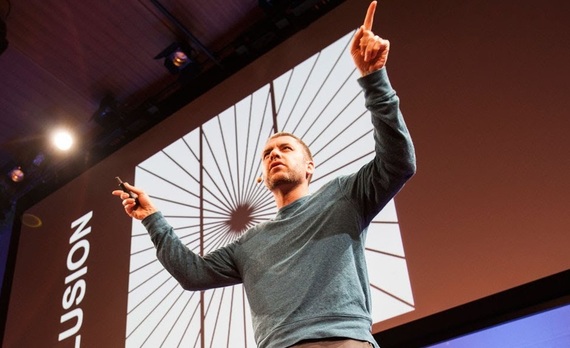With the goal of harnessing the untapped potential of Iranian-Americans, and to build the capacity of the Iranian diaspora in effecting positive change in the U.S. and around the world, the West Asia Council has launched a series of interviews that explore the personal and professional backgrounds of prominent Iranian-Americans who have made seminal contributions to their fields of endeavour. We examine lives and journeys that have led to significant achievements in the worlds of science, technology, finance, medicine, law, the arts and numerous other endeavors. Our latest interviewee is Dr. Mark Changizi.
Dr. Mark Changizi is director of human cognition at 2AI Labs. He is a prolific scientist and author, with unique cross-disciplinary expertise in cognitive science, neuro-biology, vision, optics, and language, aiming to grasp the ultimate foundations underlying why and how we think, feel and see as we do. His research has been cited for its discoveries on how and why we see in color, see illusions, and why the brain is structured as it, and how the human mind acquires writing, language and music.
He attended the Thomas Jefferson High School for Science and Technology, and then went on to the University of Virginia for a degree in physics and mathematics, and to the University of Maryland for a PhD in Mathematics. In 2002 he won a prestigious Sloan-Swartz Fellowship in Theoretical Neurobiology at Caltech, and in 2007 he became an assistant professor in the Department of Cognitive Science at Rensselaer Polytechnic Institute. In 2010 he took the post of Director of Human Cognition at a new research institute called 2ai Labs.
Dr. Changizi has more than thirty scientific journal articles, some of which have been covered in news venues such as the New York Times, Wall Street Journal, Newsweek, USA Today, Time Magazine, Reuters, ABC News, Financial Times, Daily Telegraph, Scientific American, Wired, Discover Magazine and Live Science. He has written four books, THE BRAIN FROM 25000 FEET (Kluwer, 2001), THE VISION REVOLUTION(Benbella, 2009), HARNESSED: How Language and Music Mimicked Nature and Transformed Ape to Man (Benbella, 2011), and his upcoming novel, HUMAN 3.0.
Tell our readers where you grew up and walk us through your background. How did your family and surroundings influence you in your formative years?
I grew up in the Washington DC area. Although my parents weren't scientists - my father was an Iranian trained doctor, and mother an American nurse - they were patient with my questioning, and engaged me the best they could with my early childhood interests. My dad and I would play table tennis for hours while talking philosophy and science.
Where exactly my interest in science came from is lost to the clouds of time, but I *do* know that when Carl Sagan's television series COSMOS appeared in the 80s, I jumped at the chance to watch it. What was great about the show, and was unique to it, was it treated science in a "spiritualesque" way that taps into one's heartstrings, and encourages a kid to set one's life to studying what life's all about. A regular science television show doesn't have that effect. I've written a couple pieces on what exactly was so great about COSMOS. See Here and Here.
Much of my zeal at those young ages (ten to teens) was about cosmology, but I later realized that even deeper issues existed, in mathematics at first, but also even in the neuro-sciences, biological sciences, economics, and philosophy. I write about this transition in more detail here.
Your book, "Harnessed: How Language and Music Mimicked Nature and Transformed Ape to Man," was among the N Dr. Mark Changizi ew Scientist's top ten science books of 2011. In it you describe your theory of how humans came to develop language and music. They're not instincts and they're not something we merely learn. Instead, speech and music have themselves culturally evolved to fit us by mimicking fundamental aspects of nature. Can you elaborate on it and tell us about the consequences of your theory?
Consider writing first. How is it that an ape like us, that never evolved to read - reading is *much* to recent - can read so well, so much, so young, and have brain areas seemingly devoted to it? We read as if we have a reading instinct, but of course we don't.
The answer, it occurred to me, was that perhaps the shapes of letters have culturally evolved over time to have the look of something our brains *are* good at processing. Namely, our visual systems evolved to be great at processing natural scenes and the objects in them, and in those scenes, certain kinds of contour-combinations occur, and some kinds don't occur. My hypothesis was that the contour-combinations that *do* occur in nature are the ones that, over time, writing will tend to have. ...because those are the ones our brains can handle.
And, I was able to provide strong evidence of this back in 2006 or so, that, over 115 writing systems and many other kinds of human symbols, they possess the natural kinds of contour-conglomerations, not the unnatural ones.
I say that culture "nature-harnesses" us, by which I mean that it harnesses our natural instincts, transforming those instincts for one thing into solving some altogether new function. In this case turning scene-recognition hardware in our brains into a reading machine.This is one of the things I discuss in my earlier book, The Vision Revolution.
In the next book, Harnessed, I argue that the same basic nature-harnessing idea applies not just to writing, but to spoken language as well. It's common to believe that humans have a language instinct - e.g., parts of the brain designed for comprehending spoken language. And the other viewpoint out there was that, nope, language isn't an instinct, but just one of the many crazy modern things we do with our very-plastic brains.
But an alternative possibility no one had looked into was that the sounds of language themselves had gotten shaped over time (by cultural evolution) into sounds we're great at hearing, *namely* into the sounds we constantly hear out in nature, that we evolved to be great at processing. That 's the case I make in Harnessed, that in nature, among solid objects, there are certain characterizable sounds and patterns thereof - e.g., "hits", "slides", and "rings", and many grammatical combinations thereof - and languages across humankind appear to follow the same sort of patterns. ...just as one would expect if language were "trying" to sound like natural events, just the right sort of trick to sneak their way into getting easily processed by our brains.
And music... Well, unlike speech sounds, music is deeply emotional and evocative. My own belief is that when some class of stimuli are deeply evocative, odds are the stimuli are actually *human* stimuli, even if it's not obvious that they are. Colors, for example, are deeply evocative, but *that's* because colors are about human skin, another discovery of mine. And, so I figured that music has been culturally selected to sound like something in nature and to thereby harness some instinctual mechanisms of ours, and that that something must be *human*. But what? Well, when you sit still and just listen to someone moving around you, you can tell exactly their path, their distance, their gait, their speed, their emotion, their behavior. You know all these things, although you are seldom consciously aware of it. Just as we're good at visually recognizing people and their actions and movements and faces and so on, we also have innate auditory mechanisms of recognizing people's movements and behaviors.
What I do in my book Harnessed is work out the kinds of sounds people actually make when we move. What it sounds like to you, the listener. Which sounds tell you which information. What regularities, or grammars, we find in human movement sounds. And then once we have all this rich structure, we can ask, Does *music* have this same rich structure? I make the case that music indeed does. That music has - unbeknownst to composers - culturally evolved to sound like evocative human movers moving around you, doing interesting behaviors. That's why when we put visuals to music, most of the time it's of people...moving! ...called dance!
These "nature-harnessed" research directions not only provide an entirely new style of explanation for these most important human capabilities, but also give us a newfound respect for the fruits of cultural evolution. Cultural evolution can evolve incredibly sophisticated engineering designs, designed to interact with human minds, and make those minds into something *new*. And cultural evolution does this without a designer. In this respect it's like natural selection - design without a designer. But the *speed* of cultural selection is a billion times faster than natural selection. And it basically is evolving us humans into a new kind of animal, yet doing so not by changing our biology, but by finding ever new ways of harnessing that biology for new functions.

